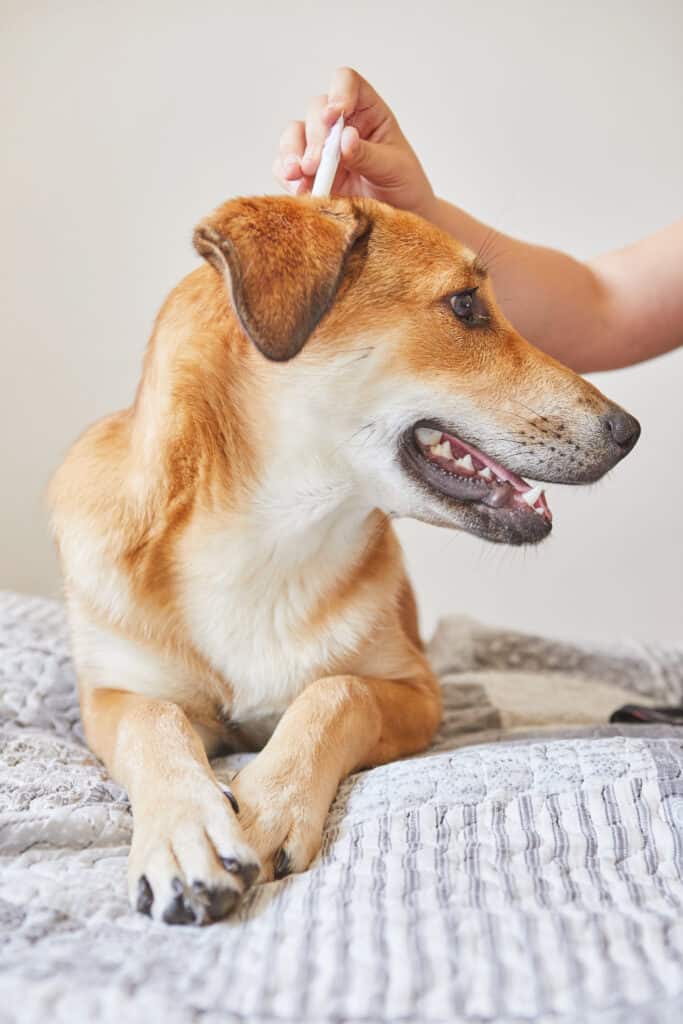If you’ve ever had to deal with trying to get rid of fleas on your dog, you know how troublesome it can be. Those aggravating little parasites can sometimes seem indestructible!
If you want to have a fighting chance against fleas, it pays to do what Sun Tzu famously advised centuries ago, and that is to “know thy enemy”. With that in mind, below are some of the most frequently asked questions about fleas.
Q: What Are fleas?
A: Fleas are wingless six-legged jumping parasitic insects that feed on the blood of mammals (such as your dog) and birds. They are classified as external parasites, which means that they pierce the skin and suck the blood from the outside (e.g., hematophagy).
The most common type of flea that plagues dogs is technically known as Ctenocephanlides felis, which actually means “cat flea”. This is somewhat of a misnomer, because this type of flea actually feeds on dogs just as much as cats.
A flea’s body features a highly compressed shape (only about one-sixteenth to one-eighth of an inch long), which makes it easy for this little insect to maneuver through the hair of your dog.
Fleas are incredible jumpers, too; in fact, they can leap vertically up to 7 inches and horizontally up to 13 inches, which is absolutely astounding in terms of the height or distance covered in proportion to their tiny body size.
Here’s a fun fact: If human beings had the same jumping power that fleas do, we would be able to leap 160 feet straight up in the air, and jump horizontally up to 295 feet in distance!
Q: Is Scratching One Of The First Signs Of Fleas?
A: Most people will tell you that your dog probably doesn’t have fleas unless he/she begins scratching a lot, but this is actually inaccurate.
Even if your dog is not scratching at all, that doesn’t necessarily mean that your four-legged friend is completely flea-free.
In fact, there are many animals that do not have sensitive skin and/or are not allergic to fleas at all, which means that they will have very little urge to scratch even if they’re loaded with fleas.
In other words, your dog might have a full-blown flea infestation and not show any signs of it, simply because their skin is not all that sensitive to flea bites.
Q: How Do I Know Whether My Dog Has Fleas?
A: You’re going to need to perform a physical inspection of your dog’s skin and haircoat in a well-lit place.
Keep in mind that fleas have a reddish-brown color, which can really make it difficult to spot them, especially if your dog’s fur is that same color. Not only that, but fleas are ridiculously fast and evasive, which means it can be hard to pin them down when you’re searching through your dog’s hair.
As you have probably guessed, the thicker or longer your dog’s fur is, the harder it’s going to be to spot fleas, but it’s not impossible by any means; you just have to be very patient and thorough with your approach.
Even if you carefully examine your dog and don’t spot any fleas, still look out for what’s known as “flea dirt”, which is actually flea feces that are usually found in the area right above your dog’s rump.
To find out if your dog does indeed have flea dirt, take a slightly damp white paper towel and rub it on that area; if you see a reddish-looking residue on the paper towel, that’s a sign that fleas have been making their home in your dog’s fur.
Q: How Do Dogs Get Fleas?
A: There are four main ways in which a dog can get fleas:
- You can actually have fleas already in your home. They can be brought in from the outside through a number of different ways, including your clothing, shoes or even wild mice.
Fleas can also be introduced into a home through bringing in objects that may have been infested with fleas, such as second-hand bedding, blankets, rugs, or plush toys.
If you buy any second-hand or used items such as these, make sure that you inspect them thoroughly for fleas or flea eggs before you bring them into your home. Once they’re in your house, fleas will find their way to your dog.
- Dogs can get fleas from the outdoors, especially if you live in a warm or humid climate. Common flea hotspots include the backyard, a dog park, kennels, dog houses, neighboring yards, under the porch, etc. Truth be told, it’s relatively easy for dogs to get fleas if they spend a lot of time outside.
- Places where dogs frequently visit (e.g., pet grooming places, doggie day cares, etc.) can sometimes be hotbeds of flea activity. When you think about how many different dogs might pass through there on a daily or weekly basis, it’s easy to see how some fleas can be left behind or transferred from one dog to another.
A good move to make would be to ask the owner of the facility how they handle any flea outbreaks or infestations before you decide to bring your dog there. If the facility adopts a lax attitude towards flea control, you can almost guarantee that your four-legged friend will bring some unwanted visitors home after your visit.
- Other animals are often carriers for fleas, and if your dog spends quite a bit of time outdoors, it can easily encounter a flea-ridden animal that might inadvertently share some of their “stowaways” with your pup.
Some examples of animals that your dog might receive fleas from include opossums, rodents, birds, squirrels, skunks, ferrets, deer, raccoon, rabbits, foxes, and bovine.
Q: How Does A Flea Suck Blood?
A: Fleas have two mouth parts that perform dual action to extract blood from their host. One part injects a type of saliva along with partially digested blood into the host, while the other part sucks blood from the host. It is through this dual action that fleas are able to transmit pathogens such as tapeworms into your dog. Okay, now all of us are sufficiently grossed out.
Q: What Is Flea Dirt All About?
A: The female flea has a real penchant for blood, consuming up to 15 times her body weight during her feeding sessions. This blood is digested and then defecated out onto the host’s skin, creating small, comma-shaped droppings known as flea dirt (disgusting, we know). This is the substance that you’ll often find above your dog’s rump area if your furry friend has been attacked by fleas.
Q: How Fast Can A Flea Lay Eggs?
A: As soon as the female flea has her first meal, she’s ready to lay eggs within 24 to 36 hours. The average flea will lay the equivalent of their body weight in eggs (about 50 total eggs) every day.
Q: What Is The Life Cycle Of A Flea?
A: Fleas are classified as holometabolous insects, which means that they go through a four-stage life cycle similar to a butterfly (egg, larva, pupa, imago). This entire cycle takes about 3 weeks to complete.
Here’s a fascinating fact: One flea can lay 1,000 eggs in 3 weeks, and then each of those 1,000 fleas can lay 1,000 eggs within the next 3 weeks, so it is entirely possible for one flea to spawn over 1 million fleas in only 6 weeks. Sounds like something out of a horror movie, but it’s actually simple mathematics!
Q: Does Cold Weather Kill Fleas?
A: Fleas are not fans of cold weather at all; in fact, they thrive best in warm, humid climates. If an adult flea is exposed to temperatures below 40 degrees Fahrenheit, it will die. In fact, flea eggs, larvae and/or pupae die if they’re exposed to temperatures below 40 degrees Fahrenheit for at least 10 days.
So how do fleas manage to survive during the harsh winters of the northern and Midwestern states? Simple – they live on a warm-blooded host, such as domestic animals (i.e., your dog) or wild mammals such as raccoons, opossums, etc.
In addition, fleas can survive extreme cold by setting up shop in places where they’re buffered from the elements, such as barns, heated garages, carpets, hay bales, and kennel bedding.
Q: Why Don’t Fleas Live On People As Much As On Dogs Or Cats?
A: Fleas are all about hanging out in dark areas, and since pets have far more hair than people (and if they didn’t, it would be really weird), fleas have more dark areas in which to hide. Fleas are quite averse to light; in fact, when you’re parting your dog’s hair to look for fleas, they act a lot like roaches in the kitchen when you turn the light on – they scramble to find cover.
Q: Can Fleas Fly?
A: No, but it sure seems like it! This is due to their phenomenal jumping ability, which as explained earlier, makes them capable of jumping heights and distances that are proportionally mind-boggling.
The mechanics of how they jump is equally fascinating: Fleas actually produce a special protein known as resilin, which acts as a “springboard” for their legs.
When a flea prepares to jump, it compresses the resilin, and then releases this substance when it springs into action. The release of the resilin basically catapults the flea in the direction it wants to go.
Q: How Do I Prevent, Control And/Or Treat Fleas On My Dog?
A: When it comes to fleas, prevention is definitely the key. This can be accomplished in a number of ways, but we’ll focus on four of the main things you can do to keep fleas from rearing their tiny, ugly heads on your dog:
1. Control your indoor environment.
This is a crucial but often-overlooked step in keeping your dog free from fleas. Here are some tips to help you keep your indoor environment a flea-free zone:
- You should vacuum your house thoroughly, especially in the areas where your dog sleeps. Remember to vacuum underneath drapes, under the edges of furniture, and in high-traffic areas.
When you’re doing a vacuuming job specifically to eliminate fleas, be sure to seal up the vacuum bag in a plastic bag and discard it right away. If you don’t, those crazy little parasites can escape, and you’ll be right back where you started before you know it. Nobody wants that!
- Invest in some type of insect growth regulator (IGR), such as methoprene (Precor), fenoxycarb or pyriproxifen (Nylar). Many IGRs come in the form of sprays, foggers or carpet powders. You can use foggers for large open areas, and sprays are good for the areas where foggers can’t reach so well, such as baseboards, corners, cracks, moldings, and under furniture.
As with any other chemical products, be sure to carefully follow the instructions, and exercise extra caution around children, people with asthma, and pets such as fish, birds, etc. Consult with your dog’s veterinarian to choose the product that will be most appropriate for your situation. If there’s a severe infestation at play, you might even need to call upon the services of a licensed exterminator.
- Wash your dog’s bedding weekly, and treat it with an IGR as well as an adulticide. Also remember to treat your car, pet carrier, basement, garage, and basically any other place where your dog tends to hang out.
2. Eliminate potential flea habitats in your immediate outdoor environment. This mainly includes places where it’s warm, humid or shady, and where organic debris tends to accumulate.
Be sure to rake away debris such as straw, leaves or grass clippings, as these are common flea habitats. Also be sure to thoroughly clean out areas such as under porches, on patios, in dog houses, etc.
3. Now it’s time to treat the fleas that are actually on your dog. Here are some ways to do it:
- Use a once-a-month topical flea treatment such as Frontline Top Spot, Bio Spot Defense for Dogs, Advantage II, Comfortis, K9 Advantix II, Revolution, and Vectra 3D. Be sure to check the labeling carefully, because there are some treatments that kill both fleas and ticks, while others kill fleas only.
- Try a flea control spray; they normally come in spray bottles or aerosol cans. It is important to remember that you don’t need to completely soak your dog with a spray; just briefly spray all of the areas around your dog’s body.
When you get to their facial area, spray a cotton ball with the treatment and then apply it manually around your dog’s eyes and ears. Remember that dogs have an extremely keen sense of smell, so you don’t want to get that spray anywhere near your dog’s nose, just out of courtesy.
- Dips are another popular option. As the name implies, a dip is a full immersion into a flea control solution mixed with tepid water. You can actually sponge the solution onto your dog using gloves, working it into their fur as they’re hanging out in the water.
Do your best to keep the solution away from your dog’s ears and eyes by putting cotton balls in your dog’s ears, and an ophthalmic ointment in their eyes to provide protection. Keep in mind that some flea dips may contain permethrins, pyrethrins, or organophosphates, so be sure that you are well-informed regarding any sensitivities your dog may have to these substances before using the solution.
- You can try using a flea and tick shampoo on your dog. This is mainly to get rid of the fleas that are currently living on your furry pal. For best results, work the shampoo over the entire area of your dog’s body, and then let it sit for about 10 minutes before you start rinsing it off. As with the flea dip, be sure to protect your dog’s eyes and ears when performing this treatment.
- Quite a few ingestible tablets are coming on the market that contain IGRs, and can be taken orally by your dog. Products such as Comfortis and Trifexis work well for killing adult fleas. Some of these products, such as Trifexis, carry the added benefit of preventing other common canine maladies such as heartworm, hookworm, whipworm, and roundworm infections.
- Put a flea collar on your dog. Collars work well, but you have to be careful how you apply the collar, or the whole thing will be for nought. If the collar is too tight, you could cause significant discomfort for your dog, so be sure to leave enough room for two fingers to fit in between the collar and your dog’s neck.
In addition, if you apply the collar and there’s a significant excess portion overlapping and hanging down, be sure to cut off this excess portion or your dog might try to chew on it. You will also need to make sure that you read the fine print regarding the durability or effectiveness of the collar in various conditions, such as if it gets wet.
If you notice any irritation or breakouts developing under the collar, discontinue use immediately and consult with your veterinarian to ensure that your dog is not having some type of adverse reaction to the collar.
- Flea combs are an excellent choice for flea prevention, even though they’re often overlooked as a viable flea treatment. Flea combs are non-toxic, making them extremely safe, and they’re also a great way to give your dog a little TLC while you’re applying an effective treatment.
Choose a flea comb that features 32 teeth per inch. When you’re combing your dog, make sure to place the fleas that you’ve combed off into water that has been mixed with detergent, as this will kill the little pests. While flea combs are a great treatment, they can be labor-intensive, which means that it will take quite a bit of time for you to comb your dog entirely. If you have a dog that has a hypersensitivity to flea bites, the comb may actually cause discomfort, in which case you will probably need to seek an alternative treatment.
Q: What Do Flea Bites Look Like?
A: The appearance of a flea bite will vary based on which mammal is being bitten. For example, flea bites on humans are typically characterized by a small red spot, surrounded by a slightly lighter red halo. Flea bites on dogs normally look like small, raised red bumps or dots, but they can also carry the look of a red rash covering a larger area.
Q: How Long Do Fleas Live?
A: Fleas live hard and die young. The average flea will live on its host for about two weeks for long haired animals, and up to a week for short haired animals. When fleas are in the pupa stage, they can actually remain dormant in their cocoon for up to a year if external conditions are not favorable (e.g., cold weather, etc.).
Once the pupa begins to sense that a host is near via warmth or carbon dioxide, it will then continue developing until it reaches the imago stage, in which it becomes a full-grown flea, ready to take on the world.
Flea larvae typically rely upon the excrement of their adult counterparts in order to survive, but if there is no excrement present, they will feed on other substances such as food particles, dead skin cells, and other not-so-appealing organic materials. Suffice it to say, fleas are pretty disgusting little creatures.
Q: How Dangerous Are Fleas?
A: While fleas are not physically intimidating by any means, they can pack a punch in terms of the damage they can do to their hosts. A “typical” flea problem won’t put your dog’s life in danger, but severe infestations can cause conditions such as anemia in your pet due to excessive blood loss.
Not only that, but fleas can also cause a condition known as Flea Allergy Dermatitis (FAD), which can really irritate your dog’s skin and cause him/her to scratch constantly, and may even cause hair loss or a rough coat.
In addition, fleas that come from wild rodents can become transmitters of diseases such as the plague and murine typhus, both of which pose a significant health risk to humans.
The Final Word
So the bottom line is, fleas are nothing to play around with! If you have discovered a flea problem, take care of it immediately!



















 Top 10 Camping Tips For Seniors
Top 10 Camping Tips For Seniors